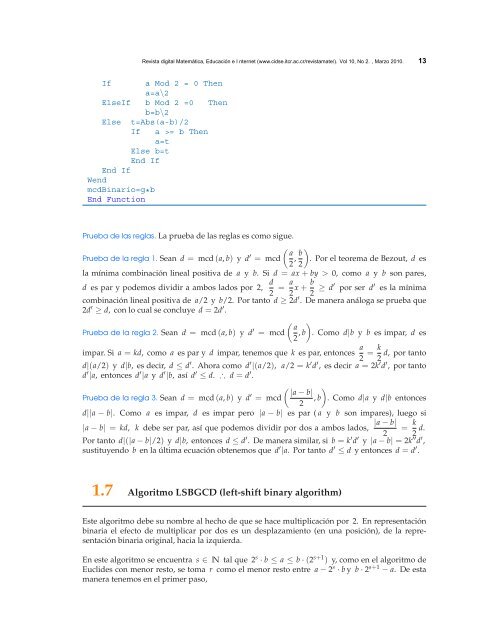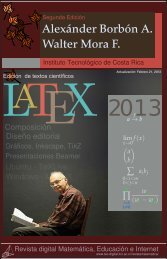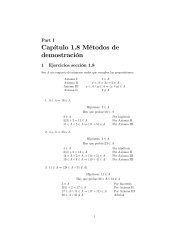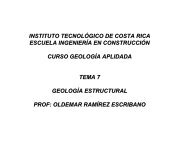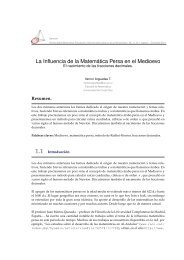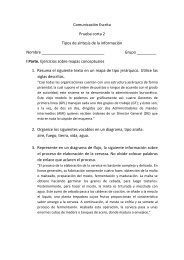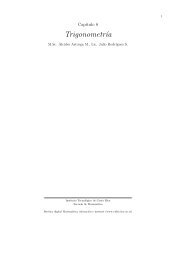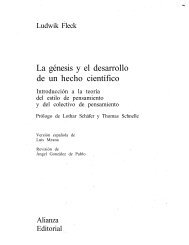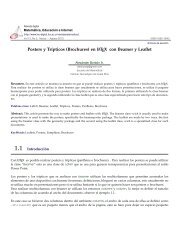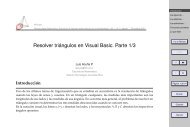1.5 Algoritmo de Euclides con menor resto. - TEC-Digital
1.5 Algoritmo de Euclides con menor resto. - TEC-Digital
1.5 Algoritmo de Euclides con menor resto. - TEC-Digital
You also want an ePaper? Increase the reach of your titles
YUMPU automatically turns print PDFs into web optimized ePapers that Google loves.
Revista digital Matemática, Educación e I nternet (www.cidse.itcr.ac.cr/revistamate/). Vol 10, No 2. , Marzo 2010. 13<br />
If a Mod 2 = 0 Then<br />
a=a\2<br />
ElseIf b Mod 2 =0 Then<br />
b=b\2<br />
Else t=Abs(a-b)/2<br />
If a >= b Then<br />
a=t<br />
Else b=t<br />
End If<br />
End If<br />
Wend<br />
mcdBinario=g*b<br />
End Function<br />
Prueba <strong>de</strong> las reglas. La prueba <strong>de</strong> las reglas es como sigue.<br />
Prueba <strong>de</strong> la regla 1. Sean d = mcd (a, b) y d ′ �<br />
a<br />
= mcd<br />
b<br />
,<br />
2 2<br />
�<br />
. Por el teorema <strong>de</strong> Bezout, d es<br />
la mínima combinación lineal positiva <strong>de</strong> a y b. Si d = ax + by > 0, como a y b son pares,<br />
d es par y po<strong>de</strong>mos dividir a ambos lados por 2, d a b<br />
= x +<br />
2 2 2 ≥ d′ por ser d ′ es la mínima<br />
combinación lineal positiva <strong>de</strong> a/2 y b/2. Por tanto d ≥ 2d ′ . De manera análoga se prueba que<br />
2d ′ ≥ d, <strong>con</strong> lo cual se <strong>con</strong>cluye d = 2d ′ .<br />
Prueba <strong>de</strong> la regla 2. Sean d = mcd (a, b) y d ′ � �<br />
a<br />
= mcd , b . Como d|b y b es impar, d es<br />
2<br />
impar. Si a = kd, como a es par y d impar, tenemos que k es par, entonces a k<br />
= d, por tanto<br />
2 2<br />
d|(a/2) y d|b, es <strong>de</strong>cir, d ≤ d ′ . Ahora como d ′ |(a/2), a/2 = k ′ d ′ , es <strong>de</strong>cir a = 2k ′ d ′ , por tanto<br />
d ′ |a, entonces d ′ |a y d ′ |b, así d ′ ≤ d. ∴ d = d ′ .<br />
Prueba <strong>de</strong> la regla 3. Sean d = mcd (a, b) y d ′ � �<br />
|a − b|<br />
= mcd , b . Como d|a y d|b entonces<br />
2<br />
d||a − b|. Como a es impar, d es impar pero |a − b| es par ( a y b son impares), luego si<br />
|a − b|<br />
|a − b| = kd, k <strong>de</strong>be ser par, así que po<strong>de</strong>mos dividir por dos a ambos lados, =<br />
2<br />
k<br />
2 d.<br />
Por tanto d|(|a − b|/2) y d|b, entonces d ≤ d ′ . De manera similar, si b = k ′ d ′ y |a − b| = 2k ′′ d ′ ,<br />
sustituyendo b en la última ecuación obtenemos que d ′ |a. Por tanto d ′ ≤ d y entonces d = d ′ .<br />
1.7 <strong>Algoritmo</strong> LSBGCD (left-shift binary algorithm)<br />
Este algoritmo <strong>de</strong>be su nombre al hecho <strong>de</strong> que se hace multiplicación por 2. En representación<br />
binaria el efecto <strong>de</strong> multiplicar por dos es un <strong>de</strong>splazamiento (en una posición), <strong>de</strong> la representación<br />
binaria original, hacia la izquierda.<br />
En este algoritmo se encuentra s ∈ N tal que 2 s · b ≤ a ≤ b · (2 s+1 ) y, como en el algoritmo <strong>de</strong><br />
Eucli<strong>de</strong>s <strong>con</strong> <strong>menor</strong> <strong>resto</strong>, se toma r como el <strong>menor</strong> <strong>resto</strong> entre a − 2 s · b y b · 2 s+1 − a. De esta<br />
manera tenemos en el primer paso,


